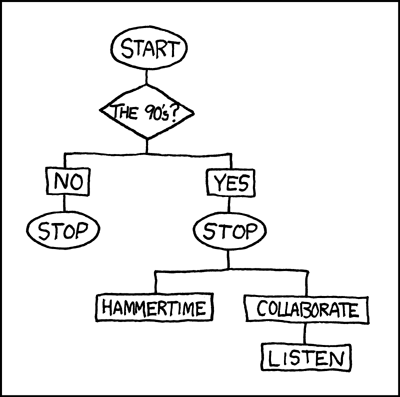90's Flowchart

Freestyle rapping is basically applied Markov chains.

Freestyle rapping is basically applied Markov chains.
Here you can see an apparent flowchart. However, it has non-standard notation. The oval normally represents either the start or stop of a process. Here, both the yes and no end up in stop, which would normally imply that nothing below can be reached.
Unless we are in the 90s, this doesn't matter, as there is nothing after the stop. But in the 90s, two processing paths follow, and both are from the lyrics of two-hit rap songs from the 90s:
- U Can't Touch This by MC Hammer, says "Break it down. Stop! Hammertime."
- Ice Ice Baby by Vanilla Ice says "All right, stop. Collaborate and listen."
In both instances, the sense of the lyric is that you should interrupt what you are doing, and switch to the new action. Interpreted in terms of flowchart terminology, we could consider that the 'stop' just pauses the main thread, and secondary threads are launched to perform the 'Hammertime' and the 'Collaborate' and 'Listen' activities.
The title text compares freestyle rapping with Markov chains. Markov chains are mathematical constructs in which the state at the next time step is dependent only upon the current state and probability, and not the state at previous times. This is somewhat similar to freestyle rapping, in which what is said next must bear some relationship to what was just said, but the "freestyle" part means that almost anything can be brought in (hence the probabilistic part); furthermore, freestyle rapping allows the rapper to say something next that bears a relationship to what was just said, but not to what was said before that. There have been several flowchart comics, all of which are listed here.
Both Ice Ice Baby and U Can't Touch This were released in the year 1990, and so their status as "90s" music is disputable. The 1st decade didn't start until year 1 (year 0 does not exist in the Gregorian calendar system), so the 2nd decade didn't start until year 11, and the 3rd decade didn't start until year 21, etc. Whether those songs count as being released in the 90s would be discussed over 2000 comics later, where VH1's I Love the '90s rules the latter (and by extension, the former) as a 90s song.